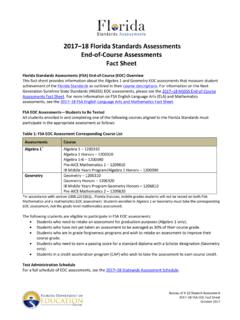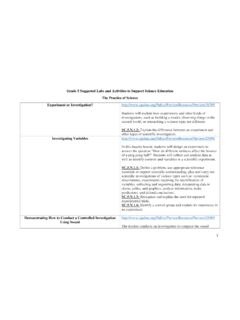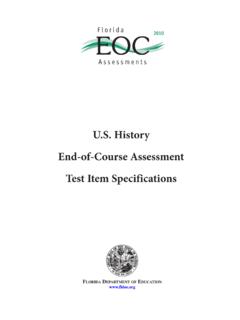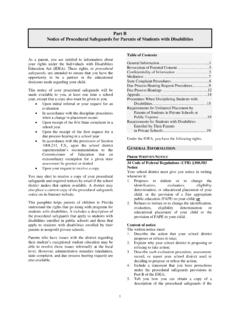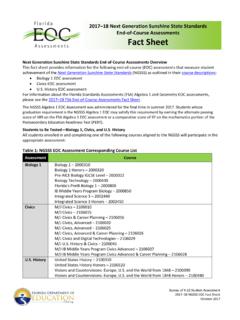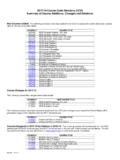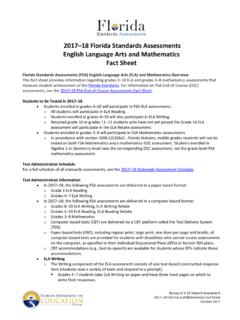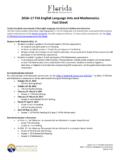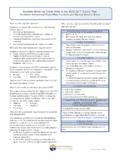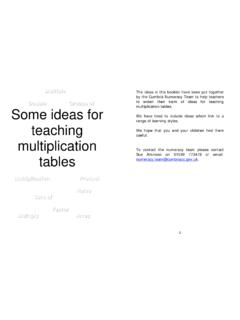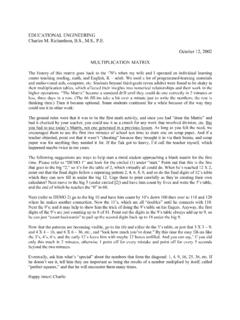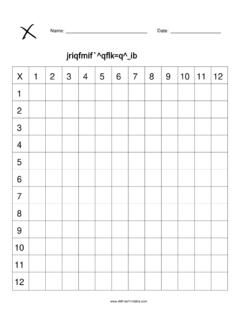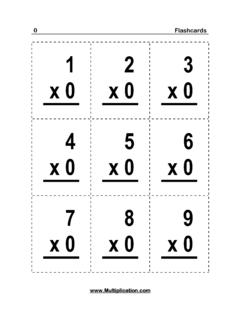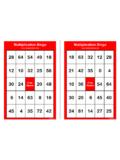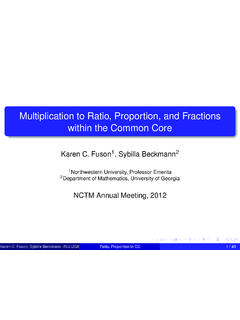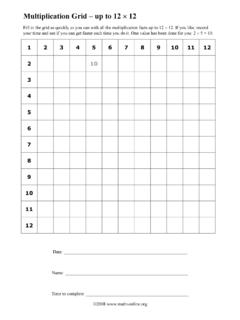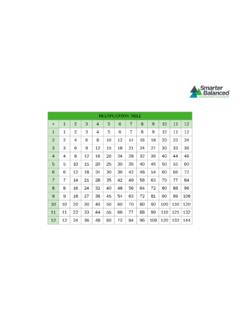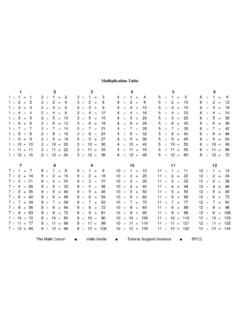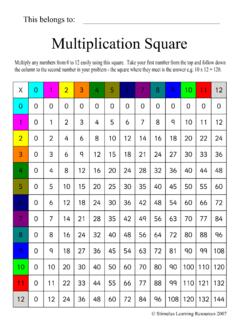Transcription of Grade 3 Multiplication and Division Unit
1 Grade 3 Multiplication and Division unit of Study This is a progressive unit of instruction beginning with students exploring Multiplication as a set through the literature Amanda Bean s Amazing Dream. Students then explore Multiplication as an array which takes them to understanding the distributive property. Although these lessons are Multiplication and Division specific as they were written, it s very easy to teach your students the concepts of Multiplication and Division side by side as they manipulate the objects and write the equations. In doing so you are walking your students from concrete to representational and finally abstract. Teaching your students the distributive property and encouraging them to compose and decompose numbers will support their Multiplication fact fluency. Operations and Algebraic Thinking Students develop an understanding of the meanings of Multiplication and Division of whole numbers through activities and problems involving equal-sized groups, arrays, and area models; Multiplication is finding an unknown product, and Division is finding an unknown factor in these situations.
2 For equal-sized group situations, Division can require finding the unknown number of groups or the unknown group size. Students use properties of operations to calculate products of whole numbers, using increasingly sophisticated strategies based on these properties to solve Multiplication and Division problems involving single-digit factors. By comparing a variety of solution strategies, students learn the relationship between Multiplication and Division . A bibliography of children's literature with a focus on Multiplication is provided, which can be integrated so that students can connect through literature. 1. Amanda Bean s Amazing Dream, Cindy Neuschwander * 2. The Grapes of Math, Greg Tang * 3. Each Orange Had 8 Slices, Paul Giganti * 4. The Doorbell Rang, Pat Hutchins * 5. One Grain of Rice, Demi * 6. Sea Squares, Joy Hulme 7. The Hershey s Multiplication Book, Jerry Pallotta 8.
3 The Lion s Share, Matthew McElliot 9. The Best of Times, Greg Tang 10. 7 x 9 = Trouble, Claudia Mills 11. 2 x 2 = Boo!, Loreen Leedy 12. Math Attack!, Joan Horton & Krysten Brooker 13. The King s Chessboard, David Birch & Devis Grebu 14. Ten Times Better, Richard Michelson Cluster 1: Represent and solve problems involving Multiplication Division Cluster 2: Understand properties of Multiplication and the relationship between Multiplication and Division Cluster 3: Multiply and divide within 100 Cluster 4: Solve problems involving the four operations, and identify and explain patterns in arithmetic Parent Resources How to Teach the Multiplication Tables to Your Child Using Arrays to Multiply The Multiplication Game 15. Divide and Ride, Stuart Murphy 16. One Hundred Hungry Ants, Elinor Pinczes 17.
4 One Hungry Cat, Joanne Rocklin & Rowane Murphy * This literature is referenced in a lesson below. Introduction to Multiplication using Literature This lesson plan can be used to introduce the concept of Multiplication to students through the use of literature. The story Amanda Bean's Amazing Dream is used to demonstrate the different ways to count items and how Multiplication can make that process much faster. : Fluently multiply and divide within 100, using strategies such as the relationship between Multiplication and Division or properties of operations. All About Multiplication This four-lesson unit from NCTM's Illuminations has students explore several meaning and representations of Multiplication (number line, equal sets, arrays, and balanced equations). Other Multiplication topics covered include: the commutative (order) property, the results of multiplying by 1 and 0, and the inverse property.
5 Students will write and solve Multiplication story problems, and convert word problems into equations. : Interpret products of whole numbers, , interpret 5 x 7 as the total number of objects in 5 groups of 7 objects each. : Fluently multiply and divide within 100, using strategies such as the relationship between Multiplication and Division or properties of operations. How Many Circles? How Many Stars? How many Circles? How many Stars? is an activity that will give students a visual representation of Multiplication and repeated addition. It will also help students see Multiplication as the combining of equal-size groups that can be represented with a Multiplication equation. : Interpret products of whole numbers, , interpret 5 x 7 as the total number of objects in 5 groups of 7 objects each. Each Orange Had 8 Slices: Multiplying Equal Groups Students will learn how to represent and count equal groups through the use of literature and situational story problems.
6 Using the story Each Orange Had 8 Slices, students will use manipulatives to create arrays to assist calculation of equal groups. Students will learn to write corresponding addition and Multiplication sentences for the arrays. : Interpret products of whole numbers, , interpret 5 x 7 as the total number of objects in 5 groups of 7 objects each. Skip Counting to Multiply (2 s, 3 s, 5 s and 10 s) Students will build a conceptual understanding of Multiplication by creating a hundreds chart, using different colors to assist them with skip counting by 2, 3, 5 and 10. Students will discuss; "How many groups of (2, 3, 5 and/or 10)?" are in each number : Fluently multiply and divide within 100, using strategies such as the relationship between Multiplication and Division or properties of operations. : Use Multiplication and Division within 100 to solve work problems in situations involving equal groups, arrays, and measurement quantities, , by using drawings and equations with a symbol for the unknown number to represent the problem.
7 Introduction to Division "The lesson will help students develop an initial understanding of Division and clarify how the four operations of addition, subtraction, Multiplication , and Division relate to and are separate from each other. The lesson begins with a brainstorming discussion which builds background and fosters comprehension. A big book, The Doorbell Rang, by Pat Hutchins, is used along with manipulatives to provide instruction at concrete and pictorial levels. Students will demonstrate what they have learned by writing a short story incorporating simple Division ." (ALEX - Alabama Learning Exchange) : Interpret whole-number quotients of whole numbers, , interpret 56 8 as the number of objects in each share when 56 objects are partitioned equally into 8 shares, or as a number of shares when 56 objects are partitioned into equal shares of 8 objects each.
8 For example, describe a context in which a number of shares or a number of groups can be expressed as 56 8. : Use Multiplication and Division within 100 to solve word problems in situations involving equal groups, arrays, and measurement quantities, , by using drawings and equations with a symbol for the unknown number to represent the problem. Pet Store Partitive Division In this lesson students will model partitive Division through the real-world activity of a pet store owner. : Interpret whole-number quotients of whole numbers, , interpret 56 8 as the number of objects in each share when 56 objects are partitioned equally into 8 shares, or as a number of shares when 56 objects are partitioned into equal shares of 8 objects each. For example, describe a context in which a number of shares or a number of groups can be expressed as 56 8.
9 : Use Multiplication and Division within 100 to solve word problems in situations involving equal groups, arrays, and measurement quantities, , by using drawings and equations with a symbol for the unknown number to represent the problem. Grandma Wants to Know! Help Mom and Dad tell Grandma about Cindy's trip to the carnival using bar models and arrays to relate Division to Multiplication with an unknown factor. : Understand Division as an unknown-factor problem. For example, find 32 8 by finding the number that makes 32 when multiplied by 8 Cheezy Arrays This lesson is a hands on activity that includes Multiplication using arrays. The lesson also serves as a great transition from repeated addition to Multiplication . Use Graph paper to show the arrays concrete to representational. : Interpret products of whole numbers, , interpret 5 x 7 as the total number of objects in 5 groups of 7 objects each.
10 : Use Multiplication and Division within 100 to solve work problems in situations involving equal groups, arrays, and measurement quantities, , by using drawings and equations with a symbol for the unknown number to represent the problem. Amazing Arrays This is a hands-on lesson for introducing and practicing building arrays to create models that represent the distributive property of Multiplication , and then using those arrays to draw models of the equations they represent. Use Graph paper to show the arrays concrete to representational. : Fluently multiply and divide within 100, using strategies such as the relationship between Multiplication and Division or properties of operations. : Apply properties of operations as strategies to multiply and divide Discovering the Mystery Factor Through Arrays Students will begin with the use of manipulatives to solve for unknown factors by building arrays.
